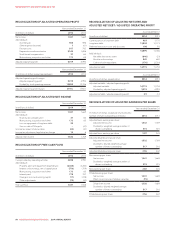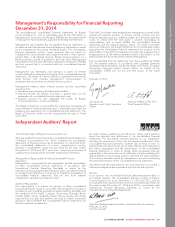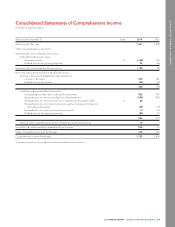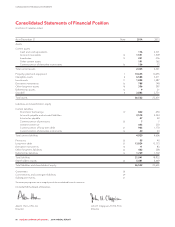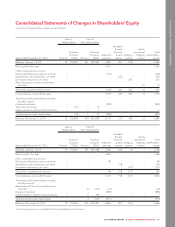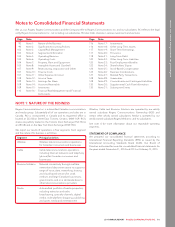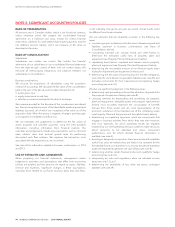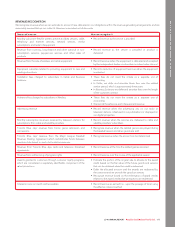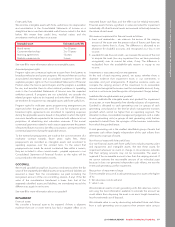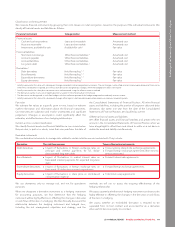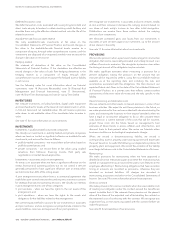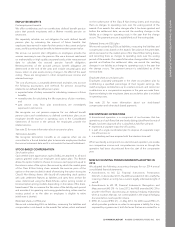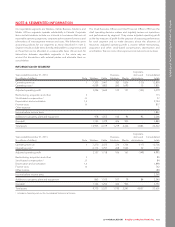Rogers 2014 Annual Report Download - page 98
Download and view the complete annual report
Please find page 98 of the 2014 Rogers annual report below. You can navigate through the pages in the report by either clicking on the pages listed below, or by using the keyword search tool below to find specific information within the annual report.
NOTES TO CONSOLIDATED FINANCIAL STATEMENTS
NOTE 2: SIGNIFICANT ACCOUNTING POLICIES
BASIS OF PRESENTATION
All amounts are in Canadian dollars, which is our functional currency,
unless otherwise noted. We prepare the consolidated financial
statements on a historical cost basis, except for certain financial
instruments, liabilities for cash-settled share-based payments and the
net deferred pension liability, which we measure at fair value as
described in the notes.
BASIS OF CONSOLIDATION
Subsidiaries
Subsidiaries are entities we control. We include the financial
statements of our subsidiaries in our consolidated financial statements
from the date we gain control of them until our control ceases. We
eliminate all intercompany transactions and balances between our
subsidiaries on consolidation.
Business combinations
We account for acquisitions of subsidiaries using the acquisition
method of accounting. We calculate the fair value of the consideration
paid as the sum of the fair value at the date of acquisition of:
• assets given; plus
• equity instruments issued; less
• liabilities incurred or assumed at the date of exchange.
We measure goodwill as the fair value of the consideration transferred
less the net recognized amount of the identifiable assets acquired and
liabilities assumed, all of which are measured at fair value as of the
acquisition date. When the excess is negative, a bargain purchase gain
is recognized immediately in profit or loss.
We use estimates and judgements to determine the fair values of
assets acquired and liabilities assumed, using the best available
information, including information from financial markets. The
estimates and judgements include key assumptions such as discount
rates, attrition rates, and terminal growth rates for performing
discounted cash flow analyses. We expense the transaction costs
associated with the acquisitions as we incur them.
Seenote26forinformationrelatedto business combinations in 2014
and 2013.
USE OF ESTIMATES AND JUDGEMENTS
When preparing our financial statements, management makes
judgements, estimates and assumptions that affect how accounting
policies are applied and the amounts we report as assets, liabilities,
revenue and expenses. Significant changes in these assumptions,
including those related to our future business plans and cash flows,
could materially change the amounts we record. Actual results could
be different from these estimates.
We use estimates that are inherently uncertain in the following key
areas:
• considering inputs to determine the fair value of assets acquired and
liabilities assumed in business combinations (see Basis of
Consolidation, above);
• considering intended use, industry trends and other factors to
determine the estimated useful lives of property, plant and
equipment (see Property, Plant and Equipment, below);
• capitalizing direct labour, overhead and interest costs to property,
plant and equipment (see Property, Plant and Equipment, below);
• determining the recoverable amount of non-financial assets when
testing for impairment (see Impairment, below); and
• determining the fair value of post-employment benefits obligations
(see note 23), stock-based compensation liabilities (see note 25) and
derivative instruments for their measurement and applying hedge
accounting (see note 16).
We also use significant judgement in the following areas:
• determining cash generating units and the allocation of goodwill for
the purpose of impairment testing (see note 8);
• choosing methods for depreciating and amortizing our property,
plant and equipment, intangible assets, and program rights that we
believe most accurately represent the consumption of benefits
derived from those assets and are most representative of the
economic substance of the intended use of the underlying assets
(see Property, Plant and Equipment and Intangible Assets, below);
• determining our operating segments, which are components that
engage in business activities from which they may earn revenues
and incur expenses, for which operating results are regularly
reviewed by our chief operating decision makers to make decisions
about resources to be allocated and assess component
performance, and for which discrete financial information is
available (see note 4);
• deciding to designate our spectrum licences as assets with indefinite
useful lives since we believe they are likely to be renewed for the
foreseeable future such that there is no limit to the period that these
assets are expected to generate net cash inflows (see note 8);
• determining whether certain financial instruments qualify for hedge
accounting (see note 16);
• interpreting tax rules and regulations when we calculate income
taxes (see note 12); and
• determining the probability of loss when we assess contingent
liabilities (see note 29).
94 ROGERS COMMUNICATIONS INC. 2014 ANNUAL REPORT


